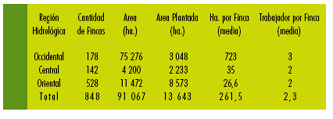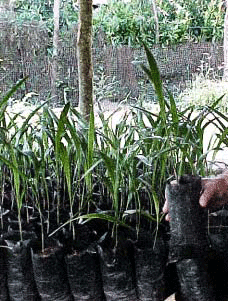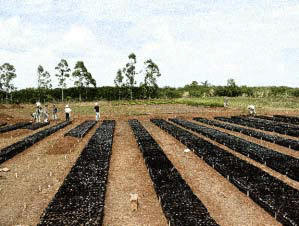Ecological forest farms, for their environmental regeneration of river basins
Results
By the beginning of 2004, 848 forest farms had been set up in the three hydrological regions of the country, an area of 91,067 hectares.
Note that the western region contains fewer but much larger farms. Given the positive results achieved by this novel method of forest administration and control, in the Province of Pinar del Río, which has the highest woodland ratio in Cuba (39%), forest companies set up 111 farms to manage 74,100 hectares of natural woodland, 23% of the total for this province.
Farms in the eastern region are smaller (an average of 26.6 ha.) but have been established in greater numbers (528), mainly in the areas earmarked for reforestation. The eastern region has a rural population of 1,512,940 (38.5% of the total), 55% of the total number of river basins, and the smallest yearly water per capita ratio (0.7 m3). It suffers from soil erosion (74.7%) and salinity (54.7%), has a forest index of 20.5 %, and is vulnerable to food shortages.
The impact of ecological forest farms in the eastern region has been very great, with 8,573 hectares planted out of 11,472 involved in this innovatory scheme. Planted areas include a belt of more than 3,000 hectares along the banks of
the river Cauto, the largest in the country, which act as a water regulator.
Forestry farms have generated great expectations of sustainable forestry development and guaranteed greater manpower resources. In just over six years, planted areas (13,643 hectares) represent almost 35% of the country’s overall annual reforestation total. In the eastern region alone, 74.7% of forest farm areas have been planted. The farms employ 1,025 workers, including women, a ratio of 8.3 hectares per worker. These figures show the convenience and importance of adopting forest farms in reforestation programmes for stable development, since they provide jobs, gender equality, family sustainability, and access to basic social services.
The Province of Las Tunas (Eastern Region), one of the most deforested in the country, where only 12% is woodland and the rural population is 41% of the total, is at the forefront in the application of this innovatory system (146 farms). Direct forestry production per 26-hectare farm is 3,300 m3 of wood (3,000 solid wood and 300 firewood), worth USD 75,092.
From the scientific and cultural points of view, forest farms complement the economic exploitation of environmental goods and services within forest ecosystems. The forest farm system benefits from a national fund for reforestation activities, which also serves to verify that sustainable criteria are being used. Through forest farms, advances or decline in forestry and agro-forestry activities can be monitored with greater precision, since they constitute smaller units of forestry management than the companies.
Forestry nursery on the banks of the river Cauto.
Furthermore, forest farms can serve as a benchmark in capacity building programmes for technicians, professionals and decision makers involved in forestry and environmental issues and technology, in the endeavour to reverse critical ecological situations in the agricultural areas the country’s river basins.
DOWNLOAD THE BROCHURE PDF
english (1.2 MB)spanish (1.1 MB)








 COUNTRY OF ORIGIN
COUNTRY OF ORIGIN